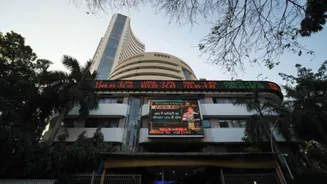Market's Initial Surge
The Indian stock market witnessed an initial positive trend, with both the Nifty and Sensex experiencing gains. This positive movement was primarily fueled
by easing tensions between the US and China, which led to a boost in investor confidence. Additionally, hopes for a Federal Reserve rate cut also played a crucial role in supporting the market's upward trajectory. These global cues set a favorable backdrop for Indian equities, encouraging buying activity and pushing the indices higher. The early gains reflected a positive response to external factors.
Profit Booking Impact
After the initial surge, the market experienced a pullback, with both the Sensex and Nifty giving up some of their gains. This correction was largely attributed to profit-booking activity among investors. As the indices reached certain levels, some investors chose to realize their profits, leading to a temporary decline in the market. The profit-taking phase highlights the natural ebb and flow of the market, where periods of growth are often followed by corrections as investors adjust their positions. The market’s response reflected a cautious approach by some, resulting in a moderate decline from the day's highs.
Nifty's Performance Analysis
The Nifty index exhibited fluctuations throughout the trading day. During the session, the Nifty briefly tested the 26,000 level, indicating a strong performance. However, as the day progressed, the index fell below the 25,950 mark, reflecting the impact of profit booking. Technical analysts are keenly observing the Nifty's ability to reclaim the 26,100 level, as a sustained move above this point could indicate further strength in the market. The index's movements illustrate the market's volatility and the interplay of various factors influencing its trajectory, providing key insights into investor behavior and overall market health.
Sensex's Performance
The Sensex experienced a similar pattern to the Nifty, showing both gains and subsequent losses. The index gained over 550 points, mirroring the positive sentiment driven by global cues and the easing of trade tensions. However, it later declined by 250 points from its intraday high, demonstrating the effect of profit booking. Despite the decline, the Sensex remained relatively strong, reflecting the overall positive sentiment and confidence in the market. This performance of the Sensex underscored the market’s capacity to absorb negative pressure while maintaining an underlying strength, despite short-term fluctuations caused by profit-taking.
Key Market Drivers
Several factors influenced the market's performance. The easing of trade tensions between the US and China played a significant role in creating a positive environment, boosting investor confidence. Hopes of a Federal Reserve rate cut also contributed to the upward momentum in the market. However, the influence of profit booking, where investors sell their holdings to realize gains, led to a correction in the indices. These three key factors highlight the complex interplay of global economic conditions, monetary policy expectations, and investor behavior in shaping the stock market’s direction and overall performance, demonstrating the sensitivity of the market to external and internal forces.
Technical Outlook
From a technical perspective, the market's performance is closely watched by analysts. The current market behavior suggests the bulls are back in action. The upcoming monthly F&O (Futures and Options) expiry is a key event, influencing market movements. If the Nifty manages to reclaim the 26,100 level, it could strengthen the bullish trend. Bank Nifty reached a record closing high. These technical indicators provide traders with crucial information to analyze market movements and make informed decisions, emphasizing the importance of technical analysis in understanding current market trends.













